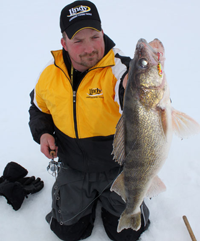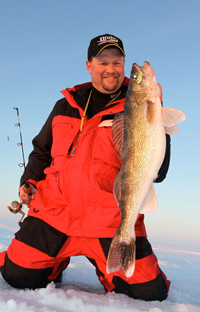
First-Freeze Walleyes On Featureless Lakes - by Daniel Quade with Jonny Petrowske
A shout echoes unanswered across the barren icepack of Minnesota’s massive Upper Red Lake. It’s hardly a call for help, much less a greeting. It’s veteran walleye guide Jonny Petrowske, proving a point about getting away from the crowd to corral first-ice ’eyes.
 “If I yell at the top of my lungs and no one hears me, I’m far enough away from other anglers,” he grins.
“If I yell at the top of my lungs and no one hears me, I’m far enough away from other anglers,” he grins.
Petrowske says that even aggressive walleyes get skittish when clamorous hordes of winter warriors overrun the ice. Since the only reply to his thunderous vociferations was the raspy, disapproving cackle of a raven drifting overhead, it appears we’re good to go.
We’re targeting early winter walleyes shortly after the mighty lake’s surface has solidified. Shallow and relatively featureless, Upper Red is typical of many fisheries that are first to freeze, and first to offer a chance at hardwater walleyes.
“It’s largely devoid of structure,” Petrowske said, “so the walleyes are nomadic, wandering vast flats looking for food.”
Catching them calls for two things, he says, finding the fish, and then not spooking them once we do.
“Since there’s nothing tying them to small area, they won’t tolerate the sound of your feet shuffling around above their heads.”
With nearly 50,000 acres at our disposal on the state-managed section of Upper Red, we have an intimidating amount of territory to cover. Petrowske quickly narrows it down to forage-rich shallows within a mile of shore.
“Depending on the lake, such areas offer walleyes everything from emerald shiners and young-of-the-year yellow perch to frogs and other forage,” he says. “Water depths of 4- to 8-feet are ideal. On lakes with slow-tapering bottoms, the search area may stretch a mile or more from the bank.”
Beginning far from shore over the deepest part of our chosen hunting grounds, Petrowske punches a string of holes spaced at 1/8-mile intervals all the way back to the shallows. At each stop, he augers a pair of portals to the underwater world 6- to 7-feet apart to allow for fishing two presentations simultaneously. Since silence is golden, he drills all of the holes in one fell swoop, which gives all spots except the last drop zone time to quiet down.
 After deftly skimming away the slush from our first hole, Petrowske pulls out a 28-inch ice rod spooled with 6-lb-test, high-visibility monofilament. A study in compromise, the blank is medium-action.
After deftly skimming away the slush from our first hole, Petrowske pulls out a 28-inch ice rod spooled with 6-lb-test, high-visibility monofilament. A study in compromise, the blank is medium-action.
“If the rod is too stiff, your jigging motions can get herky-jerky,” he says. “If it’s too soft and you exert a lot of energy bending the rod, the bait barely moves.”
A small ant swivel links the mainline to an 18-inch, 6-lb fluorocarbon leader. The swivel fights twist, while the fluoro battles abrasion and is less visible to the fish. At the end of the line he ties a Lindy Darter, a hard-bodied rattler that’s raucous on the uptake and swims on the fall.
“Not all noise is bad,” admits Petrowske. “Walleyes are curious and often check out something that sounds like a meal. And, since we’re focused on scattered fish, the ability to call them in is key when fishing a vast, featureless lake like this.”
Although the fertile water is decidedly less than gin clear, he opts for natural lure colors that mimic the lake’s forage base. Natural Perch is his favorite, but Yellow Perch and various shiner patterns are good, too. On cloudy or snowy days, brighter patterns with a touch of chartreuse get the nod.
With a plop Petrowske’s Darter drops into the ice water and quickly swims to bottom on a slack line. After tightening the tether, he twitches the rodtip several times to tap-dance the bait on bottom, generating slight puffs of sediment. Next, he raises the lure 6 inches and pauses. He says that this pause often triggers a strike.
If it doesn’t, he begins phase two. Gently swim the lure up a foot, just fast enough to lightly engage the rattles, let it fall, then lift again.
 If you’ve never fished a Darter before, he recommends practicing various lifts and drops within sight of the surface. Such swimming lessons are invaluable for learning how different jig-strokes affect the lure.
If you’ve never fished a Darter before, he recommends practicing various lifts and drops within sight of the surface. Such swimming lessons are invaluable for learning how different jig-strokes affect the lure.
Petrowske’s final performance before pulling up stakes starts off wildly animated.
“I rip the heck out of it,” he laughs, explaining that the routine includes three or four sharp lifts of 12 to 18 inches, followed by a pause. “If that fails, but I think there are fish around, I slowly jiggle the lure upward until I can see it in the hole, then open the bail so it swims off to the side and crashes like a B-52.”
After the lure touches down, he reels slowly, crawling it along bottom.
“When it gets directly beneath the hole, I raise it 6 inches and pause,” he says. He credits this “reset” maneuver to fellow guide Jon Thelen, who developed it to turn watchful ’eyes into biters. “If that doesn’t do it, I head to the next pair of holes.”
When Petrowske pinpoints a pod of active fish, he deploys a set-line in the second pre-drilled hole. The rig consists of a lively minnow tail-hooked on a jig or jigging spoon and suspended 8 to 12 inches off bottom beneath a bobber.
“Lindy’s Rattl’n Flyer Spoon, Frostee and Frostee Spoon are my favorite lures,” he says, noting that slip-floats with large metal grommets, such as members of Thill’s Pro Series lineup, limit ice buildup.
Strung with 4-pound Silver Thread Trout Line or AN40, the bobber rod tempts hungry ’eyes that were lured in by Petrowske’s jigging theatrics, but not tempted enough to strike. It’s one more ploy in his bag of tricks for taking first-freeze walleyes in shallow, featureless lakes.
Home | Current Fishing Report | Saved Fishing Reports | Favorite Lakes | Fishing Articles Section | Recipes | Rates Services | Gift Certificates | Contact | For Sale | Links | Sitemap |
"The Early Bird Fishing Guide" Jeff Sundin - Fishing Blue Books, LLC 715 Byington Ave, LaPrairie, MN 55744 218-245-9858
Email copyright©2017 Fishing Blue Books, LLC All Rights Reserved - last revised 11-14-17